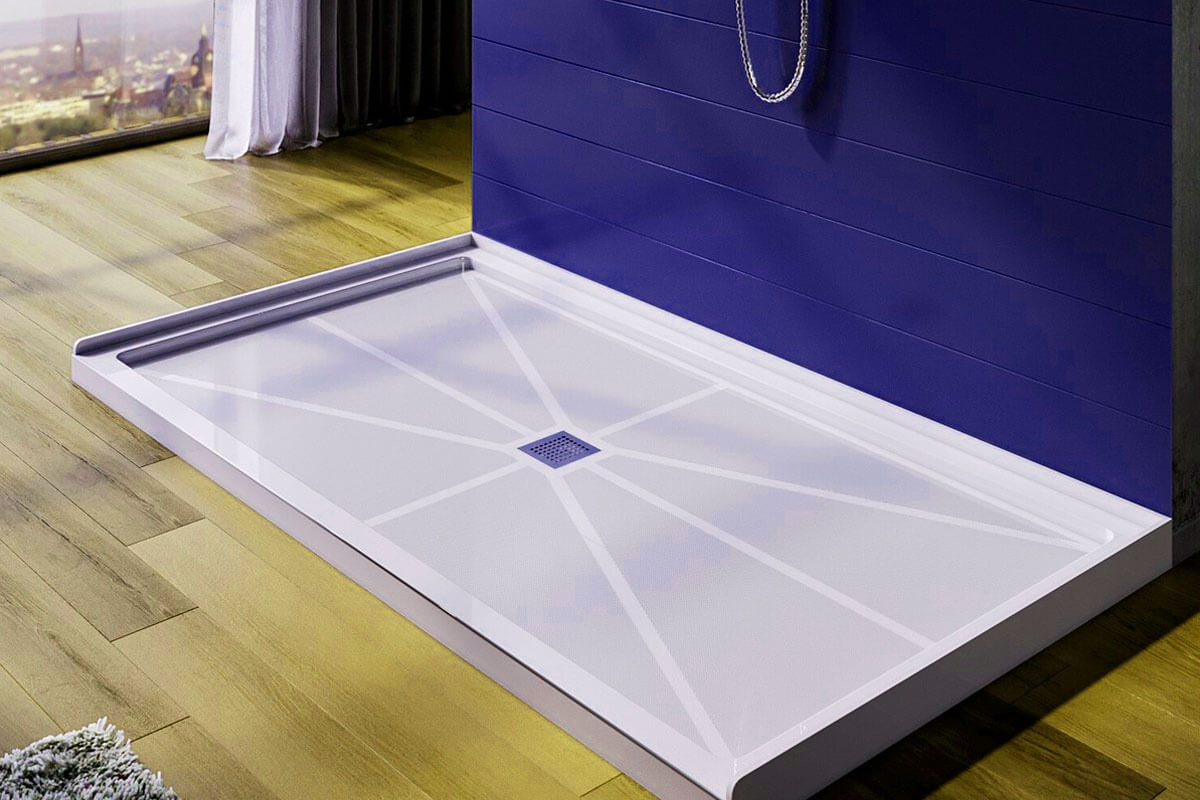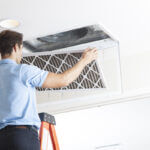Installing a Schluter shower pan creates a watertight shower base without the mess of traditional mortar beds. The system uses a prefabricated foam tray with integrated waterproofing that bonds directly to your substrate using thin-set mortar. You can complete the proper installation in one day, but you must test for leaks before tiling. This guide covers everything from choosing your tray type to passing your final inspection for your bathroom remodel.
Materials, Tools, and Substrate Requirements
You need the right supplies before you start this shower base installation. Your essential materials include a Schluter foam tray, KERDI-DRAIN assembly, thin-set mortar (preferably ALL-SET), KERDI waterproof membrane, KERDI-BAND sealing strips, and a notched trowel (1/4″ x 3/8″ square notch). Using the wrong thin-set mortar is one of the first mistakes homeowners make, so ensure you select either Schluter ALL-SET or unmodified thin-set that bonds to the bonding fleece on the pan, walls, and banding. Your tools should include a circular saw or table saw for cutting the tray, a mixing drill, measuring tape, level, and test plug for leak testing.
Your substrate must be clean, level, and structurally sound before installation. The substrate can be plywood, OSB, or concrete and must be clean, even, and load bearing. Remove any dust, debris, or loose material. Check that your drain rough-in sits at the correct height. The drain should align with the prefabricated tray’s drainage opening, typically positioned 3 to 4 inches above the finished floor level. Wipe down wood or concrete substrates with a damp sponge to hydrate the surface and prevent it from absorbing moisture from the thin-set mortar. If your substrate has dips or high spots, level them now because the foam tray won’t bridge gaps or correct major imperfections.
Choosing Between Foam Tray vs Mortar Bed Installation
The foam tray method uses prefabricated Schluter KERDI-SHOWER trays that eliminate the need for a mortar bed. This approach saves time and reduces installation complexity. The mortar bed method involves building a sloped base using deck mud (dry pack mortar) with a waterproof liner underneath. This complete shower system from Schluter is an integrated waterproofing solution that simplifies installation while enhancing longevity. Most installers now prefer foam trays for residential projects.
Foam trays work best for standard shower sizes and new construction. They’re made of high-density expanded polystyrene foam and come in various rectangular sizes, neo-angle shapes for corners, and can be cut to custom dimensions. The KERDI-SHOWER-T is the standard tray with center drain placement available in sizes from 38″ x 60″ up to 72″ x 72″, while KERDI-SHOWER-TT features a thin perimeter height that simplifies curbless shower construction. You can trim the tray to fit existing drain locations using a circular saw or table saw. Choose the mortar bed method only when you need extreme customization, have unusual floor conditions, or work in commercial settings with specific code requirements. The foam tray installs faster, weighs less, and provides consistent slope. The mortar bed requires more skill and curing time but offers unlimited shape flexibility. Avoid trying to mix both methods by placing a membrane over a mortar bed with a foam tray, as this creates trapped moisture issues between waterproofing layers.
Step-by-Step Installation Process
Start by positioning your KERDI-DRAIN assembly. Apply thin-set mortar where the drain flange will be positioned, then press the flange into the mortar bed, ensuring it sits level and securely bonded. When you lack access to plumbing from below, install the drain to the appropriate height and connect it to the waste line before setting the shower base. Thread the drain through the tray opening and hand-tighten the assembly components.
Mix your thin-set mortar to a smooth, fairly fluid consistency that still holds notch marks. Follow mixing instructions for setting membranes rather than for setting tile, as this keeps the mortar hydrated so it bonds properly to the fleece of the Schluter system. Apply thin-set to your substrate using the flat side of your notched trowel first to key it in, then apply more and trowel it in the same direction toward the shower curb while holding the trowel at a 45-degree angle. This ensures maximum coverage. Apply thin-set parallel with the shortest side of the shower pan for best results. Position your tray immediately into the wet mortar and walk on it to embed it fully. The mortar should squish up through the foam channels on the tray’s underside. Check for level across the tray’s flat perimeter and proper slope toward the drain. Allow the mortar to cure for at least 24 hours before proceeding.
Setting the Drain Assembly and Tray
The first 3/4 inch perimeter of Schluter shower trays is flat to help with setting vertical wall tile. Cut off the 3/4 inch perimeter, then trim the shower tray to the desired dimensions using either a table saw or circular saw. Save those 3/4 inch strips because you’ll set them alongside the main tray in thin-set during the foam tray setup.
Apply thin-set mortar in consistent ridges across your substrate. Set the tray down carefully, aligning the center hole with your drain pipe. Immediately embed the tray and 3/4 inch strips into the thin-set and walk on them to properly embed the tray. The drain can be installed to the appropriate height before the tray, or you can thread it through after positioning the tray. Tighten all drain components according to manufacturer specifications. If you need to extend a Schluter shower tray beyond its standard dimensions, use deck mud mixed with sand and Portland cement or pre-mixed Mapei 4-to-1 Mud Bed Mix. Mix the mud bed before setting the shower pan, then install the pan with ALL-SET and immediately add the mud bed mix over the wet thin-set mortar so they bond together properly. Clean excess mortar from around the drain opening before it hardens. Verify the tray sits level on the flat edges and slopes correctly toward the center drain point.
Waterproofing Membrane and Edge Seals
Apply KERDI waterproofing membrane to all walls and horizontal surfaces using thin-set mortar that penetrates and engages the membrane fleece. The system creates a fully waterproof and vapor-tight enclosure in tiled showers and residential steam showers. The mortar must be mixed to fairly fluid consistency. Use the Schluter KERDI trowel when applying thin-set mortar for waterproofing, as this 1/8 inch by 1/8 inch square notch trowel sets the proper notch depth. Spread thin-set on the wall with the flat side of your trowel, then use the notched side. Press the KERDI membrane into the wet mortar and smooth it with the flat side of your trowel to eliminate air pockets.
All seams require KERDI-BAND strips bonded with thin-set mortar, creating a 2-inch overlap for waterproof connections. Schluter requires overlapping the two fabrics by no less than 2 inches and pressing them together with a thin layer of mortar between them, a method used by many competing systems because it works reliably. Bond the membrane to the drain’s integrated bonding flange using thin-set or KERDI-FIX sealant to form a waterproof connection at the top of the assembly. Apply KERDI-BAND waterproofing strips over all inside and outside corners, wall-to-floor transitions, and curb edges. Use prefab KERDI-KERECK inside and outside corners, then add KERDI-BAND so it overlaps the corner by at least two inches. Install shower curbs by applying thin-set to the tray edge, floor, walls, and all curb surfaces before bonding the curb components. Double-check that curbs sit level and seal properly at all connection points. Pay special attention to corners where multiple surfaces meet.
Testing, Troubleshooting & Common Mistakes
Perform a water test before setting tile by stopping the waste line with a test plug and filling the shower base completely with water to check for leaks. This quality control check catches problems before you invest time and money in tile installation. Wait a minimum of 24 hours after setting KERDI membrane before beginning water testing to allow thin-set mortar to reach final set. Allowing the mud bed mix to fully cure before testing is critical, as insufficient curing time could cause the waterproofing to fail.
Fill the pan so the membrane to drain connection and all floor-to-wall transitions are fully submerged. Mark the water level on the shower wall and leave the assembly for 24 hours (48 hours is better for certainty). If the water holds that level for 24 to 72 hours, you don’t have leaks and the test is successful. Check surrounding areas including the subfloor and adjacent rooms for water stains or damp spots. If the water level drops significantly, you have a leak. Drain the water, locate the problem area, make repairs, and retest. Common leak sources include the drain connection, membrane overlaps at seams, corners, and the tile bonding surface where KERDI meets the drain flange.
Common mistakes include inadequate thin-set coverage under the tray (leaving voids), improper slope toward the drain, misaligned drain assembly, insufficient membrane overlap at seams (less than 2 inches), and skipping the flood test entirely. Another frequent error is not embedding the tray fully by walking on it immediately after setting. Mixing thin-set with incorrect water amounts results in uneven application and poor water sealing qualities, so pay careful attention to mixing ratios and consistency. Installing shower pans without proper slope creates standing water issues and accelerates mold growth, while incorrect waterproofing membrane application leaves gaps at corners and seams leading to water infiltration. Fix voids by carefully lifting the tray and adding more mortar. Correct slope issues by removing the tray and adjusting your substrate. The 2-inch thin-set overlap at membrane seams prevents water from traveling past that point when properly installed. Always follow manufacturer specifications exactly. For complex issues, contact Schluter’s technical support line for guidance.
Tiling and Finishing Over the Schluter Pan
The Schluter system is compatible with various tile types including ceramic, porcelain, and stone tiles. This flexibility lets you achieve modern, rustic, or minimalist designs. Choose tiles appropriate for shower floors with adequate slip resistance. When tiling the shower floor, consider using smaller tiles or mosaics that naturally follow the slope toward the drain. Calculate your tile layout before mixing adhesive.
Use ALL-SET or another suitable modified thin-set mortar to bond tile directly to the waterproofed surfaces. Apply mortar with an appropriate notched trowel size for your tile dimensions. Larger tiles require larger notches for proper coverage. Begin tiling from the floor up, using tile spacers and a level to maintain straight lines. Set tiles starting from the drain and working outward, maintaining consistent grout joints. Use spacers to keep joints uniform. Back-butter large format tiles to ensure full coverage. Recent Schluter foam shower bases now include an attached tile bonding layer on the foam surface to solve adhesion concerns with uncoated foam. Avoid tile lippage by checking with a straightedge as you work. Let the tile bonding surface cure according to mortar manufacturer recommendations before grouting, typically 24 to 48 hours. Mix grout to proper consistency and work it into joints using a rubber float. Clean excess grout with a damp sponge, changing water frequently. Seal grout lines after they cure fully to protect against moisture penetration and staining.
Maintenance, Inspection, and Repair Tips
Your Schluter shower requires minimal maintenance when installed correctly. Inspect the shower periodically for raised spots, especially in corners, and check grout lines for cracks or deterioration. Reseal grout annually or as needed to maintain water resistance. Look for discoloration on walls adjacent to the shower or on ceilings below, which can indicate slow leaks. Regular inspection prevents the need for complete removal and reinstallation.
Clean your shower regularly with pH-neutral cleaners. Avoid harsh chemicals that can damage grout or sealant. Check the drain cover periodically and remove hair or debris that could slow drainage. If you notice unusual dampness or water seepage, inspect the drain area and wall-to-floor transitions first. Small grout cracks can often be repaired by removing damaged grout and reapplying fresh grout. For membrane damage, consult with a professional or contact Schluter technical support for repair procedures. Schluter’s tech line is very helpful, and if it’s a Schluter problem, they’re willing to accept responsibility and help even with installer error. Address any issues promptly to prevent water damage to underlying structures. Keep documentation of your installation including photos, product specifications, and warranty information. This helps with future repairs and demonstrates proper installation if warranty claims become necessary.
Key Points Covered
This article provided you with five critical elements for successful Schluter shower pan installation:
- Proper substrate preparation and material selection – ensuring your floor is level, clean, and compatible with the foam tray system while selecting the correct thin-set mortar type
- Correct thin-set application and tray embedding – using the right mortar consistency, proper trowel angle, and walking on the tray to eliminate voids that could compromise the shower assembly
- Thorough waterproofing with KERDI membrane – creating 2-inch overlaps at all seams and bonding properly to the drain flange using appropriate trowel sizes
- Mandatory flood testing before tiling – filling the pan completely and monitoring for 24 to 48 hours to catch leaks early and ensure watertight performance
- Long-term maintenance practices – regular inspections, grout sealing, and prompt repair of any issues to prevent water damage and mold growth in your bathroom waterproofing project
Following these steps for your waterproofing system setup ensures your shower remains watertight for years while protecting your home from costly water damage and mold growth.





